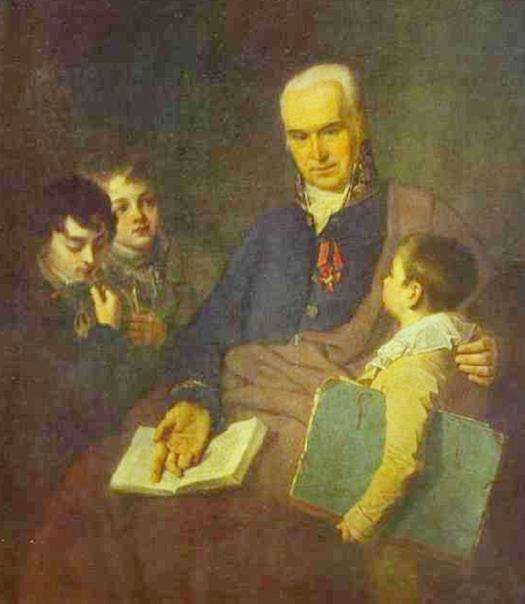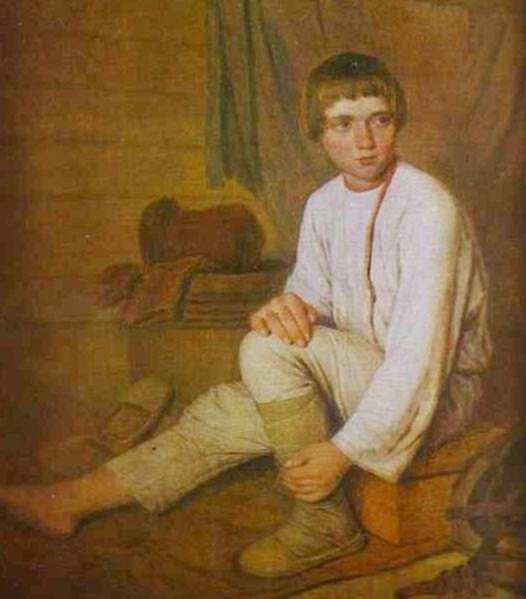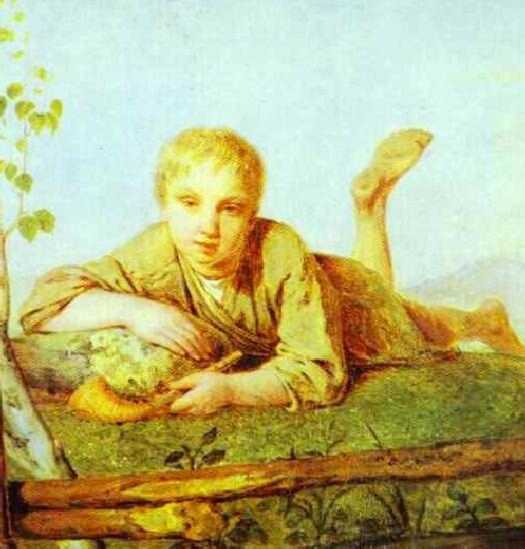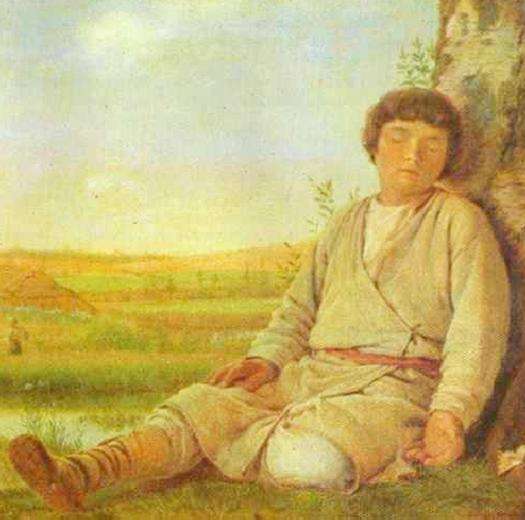
Artists Illustrating Boys' Fashions: Alexey Venetsianov (Russia, 1780-1847)

Figure 1.--Venetsianov painted "Portrait of K. I. Golovachevsky and the Younger Pupils of the Academy" in 1811, one of the earliest of his important works. It is located in the Russian Museum in St. Petersburg, Russia. These were boys from affluent families. Notice the one boys lace collar.
|
Alexey Venetsianov was active in the early 19th century and is one Russia's most famed genre painters. Venetsianov introduced new types of painting to Russia. His genre work include some of the earliest image pf peasant life. He painted some
wonderful images of early 19th century Russian life. This was a great departure for Russian art which had previously focused on religious subjects and portraits of the upper class. Some of his early portraits depict upper-class life. His best remembered
paintings, however, are his masterfull images of Russiam peasant life in the years just before the abolotion of serfdom. Some of
the paintings include Russian serf boys.
Childhood
Alexey Gavrilovich Venetsianov was born in Moscow during 1870. His father was a merchant of Greek origins.
Education
Goverment Service
One report indicated taht Venetsianov entered state service in the early 19th century. HBC assumes that means he began working in the Tasrist beauracracy. He moved to St. Petersburg (Leningrad during the Soviet era) which at the yime was the capital of Russia.

Figure 2.--Venetsianov painted "Peasant Boy Putting on Bast Sandals" about 1823-27. It is located at the Russian Museum, St. Petersburg, Russia. Bast was a kind of woody fiberous plant (like hemp) used to manufacture woven goods, in this case inexpensive footwear.
|
Interest in Art
Venetsianov apparently did not study art as a child. He appears to have had little interest in his work as a beaureaucrat. While working as a beaureacrat he used his spare time he began to study art. He copied pictures in Hermitage. He then began painting friends. He got acquainted with the outstanding painter of thevday--Vladimir Borovikovsky. He even lived for a while at Borovikovsky's home as a disciple.
Career
Venetsianov tried to work as a freelance portraitist, but was unable to garner many commissions. Finally in 1811, a year before Naploeon invaded Russia, the Board of the Academy of Arts awarded Venetsianov the prestigious title of an Academician for two of his works--"the "Self-Portrait" and "Portrait of K.I. Golovachevsky and the Younger Pupils of the Academy". This award helped hive his the prominance needed to win commissions.
Venetsianov in 1819 decided to quit his Government job so he could devote himself full time to pursuing hist artistic endevors. He bought a home in Safonkovo villiage in Tver province, and settled there. He decided to paint the surrounding life as it was, focusing on village peasant life. During the 1820s, Venetsianov executed many works about peasant life and now constitute a major contribution into Russian art. He painted portraits of peasants, scenes of rural life; he depicted them realilitically with great sympathy and a touch of sentiment.

Figure 3.--Venetsianov painted "A Herd-Boy with a Pipe" in the 1820s. It is located at the Picture Gallery, Tver, Russia. Russian serf boys went barefoot much of the year, except during the cold winter months.
|
Venetsianov's genre work constitued a great departure for Russian life. His pictures, such as "In the Fields. Spring" (1827), "Harvesting. Summer." (1827), "Sleeping Herd-Boy" (1824) and others he was the first Russian artist to depict peasants. His works were revelation and proved of great success at the exhibition of 1824. He also received favorable comments in the press.
Venetsianov wanted to become a professor in the Academy of Arts, but the the academicians did not approve him. He did not have the expected background. He was a stranger of foreign extraction. He lacked the academic training that the academicians cexpected. Actually Venetsianov was a natural teacher. As his reputation developed, he began to attract young artist from humble origins without the mwans to aford academic study. He open a school for peasant children in 1818. He even attracted serf boys, most of whom he was able to arrange to emancipate. By the middle 1820s he had gathered a group of disciples and was able to start his own school of painting. Tsar Nicholas I, the tsar who helped defeat Napoleon, liked to stimulate "national trends". He expressed his approval to the artist and appointed him a court painter. This title gave him a financial support he needed to sustain a school which charged virtually no tuition.
Soviet Approval
It is easy to see why Venetsianov was such a favorite durin the Soviet period. Not only did his art focus on peasant life, but he helped train aspiring artist of modest means--even serfs.
Final Years
Venetsianov died in an accident in 1847: his horses dashed off and the carriage fell down from a steep slope.

Figure 4.--Venetsianov painted "Sleeping Herd-Boy" in 1824. It is located in the Russian Museum, St. Petersburg, Russia. Notice how the serf boys pictured on these pages wear clothes with few or no buttons. Apparently buttons were expensive.
|
Clothing
One of the major activities in which boys, rarely girls, were used was to heard livestock. Two of the image here show serf heardboys. These boys would be with the animals in both warm and cold weather. Heard boyy are depicted here in both warm and cool weather clothes. One boyis is shown barefooted, presumably during the summer. In the summer serfboys were clothed usually only in canvas shirts and pants (figure 3). Another boy is shown wearing bast footwear, probably in the spring before the weather has warmed up. The boy wears a shirt have also in a long linen jacket (kaftan) and bast foowear. Such clothes were orn in spring or autumn. Probably spring is depicted in figure 4. At this time inmiddle and northern Russia still it is still cold and the serfboys would still wear their bast shoes (lapti). In the summer when the weather warmed they would go barefoot.
Serdom, the Russian form of feudalism, played a major role in Russian life through the 19th century when it was abolished. Serfdom was more humane than American race-based chattle slavery, but serfdom as also a brutal system which tied millions of Russians to the land. Even freed slaves were descriminated against. The influence continued into the 20th century. An assessment of Russian boys' clothing would thus be incomplete withoutan assessment of serfdom. Some Russian boys even in the 19th century look much like European boys. Other Russian boys, especiall serf boys and rural village boys dressed very destinctly.
The inspiration of the Russian blouse style can clearly be seen in Makovsky paintings of traditional Russian folk dress. The style was worn by both boys and men, although it became primarily a boys' style in Europe. Both blouses and tunics were made in the Russian style.
Christopher Wagner

Navigate the Boys' Historical Clothing Web Site:
[Return to the Main individual S-Z artist alphabetical page]
[Return to the Russian garment page]
[Introduction]
[Activities]
[Bibliographies]
[Biographies]
[Chronology]
[Clothing styles]
[Countries]
[Contributions]
[FAQs]
[Glossaries]
[Satellite sites]
[Boys' Clothing Home]
Created: January 13, 2002
Last updated: January 15, 2002






